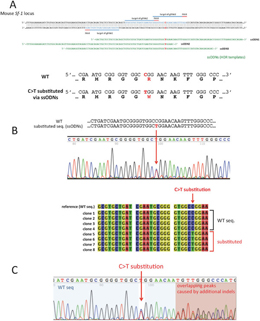Research Abstract
CRISPR/Cas9系を用いた特定の点変異を持つマウスモデルの迅速な作製
Rapid generation of mouse models with defined point mutations by the CRISPR/Cas9 system
2014年6月23日 Scientific Reports 4 : 5396 doi: 10.1038/srep05396

点変異の導入は、遺伝要素の特定のヌクレオチドあるいはタンパク質の特定のアミノ酸の役割を検証するのに使われる基本的な方法であり、培養細胞と外来のDNAを用いてin vitro実験で広く用いられている。しかし、ゲノム配列を改変することでこの点変異導入アプローチをin vivoに適用することは、その技術的および時間的な負担が大きいため、まれである。このため、in vitroでの多くの知見がin vivo条件下では実証されていない。本論文では、CRISPR/Cas9系を適用して、ゲノムに目的のタンパク質の単一のアミノ酸置換を引き起こすような点変異を持つマウスを作製したことを報告する。マウス受精卵にgRNA、hCas9 mRNAおよび一本鎖ドナーオリゴヌクレオチド(ssODN)をマイクロインジェクションすることにより、低価格かつ短時間でマウスゲノムに特定のゲノム改変を導入した。単一のgRNA/WT hCas9と2つのgRNA/変異型hCas9(ダブルニッキング)の両方が有効であった。改変部位とgRNA標的部位の間の距離が、この置換の効率に影響を与える重要なパラメーターであることも分かった。我々は、今回の方法がin vivo系において、in vitroでの知見や、遺伝学的疾患の患者に見られる変異の意義の検討に用いることができる有用な技術であると考えている。
乾 雅史1, 宮戸 真美2, 五十嵐 麻希2, 玉野 萌恵1, 久保 純3, 山下 聡1, 浅原 弘嗣1,3,4,5, 深見 真紀2 & 高田 修治1
- 独立行政法人国立成育医療研究センター研究所 システム発生・再生医学研究部
- 独立行政法人国立成育医療研究センター研究所 分子内分泌研究部
- 東京医科歯科大学 大学院医歯学総合研究科 システム発生・再生医学分野
- 科学技術振興機構 CREST
- スクリプス研究所 分子実験医学部門(米)
Introducing a point mutation is a fundamental method used to demonstrate the roles of particular nucleotides or amino acids in the genetic elements or proteins, and is widely used in in vitro experiments based on cultured cells and exogenously provided DNA. However, the in vivo application of this approach by modifying genomic loci is uncommon, partly due to its technical and temporal demands. This leaves many in vitro findings un-validated under in vivo conditions. We herein applied the CRISPR/Cas9 system to generate mice with point mutations in their genomes, which led to single amino acid substitutions in proteins of interest. By microinjecting gRNA, hCas9 mRNA and single-stranded donor oligonucleotides (ssODN) into mouse zygotes, we introduced defined genomic modifications in their genome with a low cost and in a short time. Both single gRNA/WT hCas9 and double nicking set-ups were effective. We also found that the distance between the modification site and gRNA target site was a significant parameter affecting the efficiency of the substitution. We believe that this is a powerful technique that can be used to examine the relevance of in vitro findings, as well as the mutations found in patients with genetic disorders, in an in vivo system.

